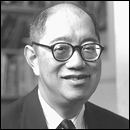Name Tai Wu | ||
 | ||
Awards Guggenheim Fellowship for Natural Sciences, US & Canada | ||
Tai Tsun Wu (simplified Chinese: 吴大峻; traditional Chinese: 吳大峻; pinyin: Wú Dàjùn, September 1, 1933) is a Chinese-born American physicist and applied physicist well known for his contributions to high-energy nuclear physics and statistical mechanics.
Contents
Born in Shanghai, he studied electrical engineering at University of Minnesota and became a William Lowell Putnam Mathematical Competition fellow (1953). He obtained an S.M. (1954) and Ph.D. (1956) in applied physics from Harvard University. His thesis concerned I. The Concept of Impedance II. High Frequency Scattering and was advised by Ronold W. P. King. At Harvard, he continued as Junior Fellow in the Society of Fellows (1956–59), joined the faculty of applied physics (1959) and is currently the Gordon McKay Professor of Applied Physics & Professor of Physics. Wu has also had visiting appointments with Rockefeller University (1966), at the DESY in Hamburg, Germany (1971), at CERN in Geneva, Switzerland and Utrecht University (1977)
He has studied statistical mechanics on Bose–Einstein condensation in an external potential, classical electromagnetic theory (1960). With Hung Cheng, he used gauge quantum field theory to predict the unboundedly increasing total scattering cross sections at very high energies, experimentally verified at CERN and Tevatron collider. Wu studied production processes for the Large Hadron Collider, in particular to predict the production cross section of a Higgs particle with low momentum together with two forward jets. With Chen Ning Yang he studied CP violation and what not such as globalization of the gauge theory. More recently, Wu has studied quantum information processing based on the Schrödinger equation without any spatial dimension in the modeling and application of quantum memories.
